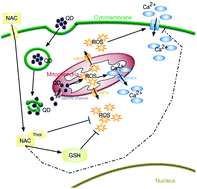Partial protection of N-acetylcysteine against MPA-capped CdTe quantum dot-induced neurotoxicity in rat primary cultured hippocampal neurons
Abstract
As one of the most frequently used quantum dots (QDs), the toxicity of cadmium telluride (CdTe) QDs related to several body systems has been investigated, but the studies on the nervous system are rather limited. It is extremely important to assess QDs’ cytotoxicity to neurons by a thorough systematic and quantitative analysis before they are applied in scientific or clinical settings. This study observed that CdTe QDs caused cell death and apoptosis in rat primary cultured hippocampal neurons in a dose-, time- and size-dependent manner. QD-exposed neurons showed an increase in reactive oxygen species (ROS) and intracellular calcium levels that leads to neuron apoptosis and even death, which may be completely or partially protected by a common antioxidant N-acetylcysteine (NAC), respectively. For future research, it is necessary to study the underlying mechanisms by investigating the extrinsic and intrinsic pathways by which CdTe QDs induce neurotoxic effects.

- This article is part of the themed collection: Nanotoxicology

 Please wait while we load your content...
Please wait while we load your content...